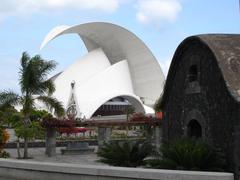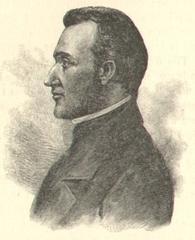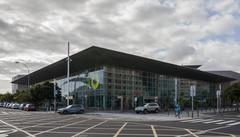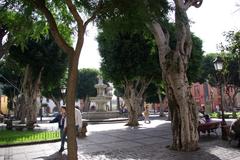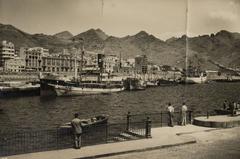Batería de Santiago Visiting Hours, Tickets, and Travel Guide in Santa Cruz de Tenerife
Date: 14/06/2025
Introduction
Batería de Santiago, a historic coastal battery in Santa Cruz de Tenerife, stands as a testament to the city’s rich military heritage and its pivotal role in defending the Canary Islands from maritime threats. Though the original structure no longer exists, the site’s legacy is preserved through archival records, surviving masonry, interpretive trails, and museum exhibits. This comprehensive guide provides an in-depth look at Batería de Santiago’s history, architectural features, visiting information, accessibility, nearby attractions, and practical travel tips to help you make the most of your visit to this emblematic Santa Cruz historical site (tenerife-is.com, Capture the Atlas).
Historical Overview
Origins and Construction
The strategic location of Tenerife in the Atlantic made Santa Cruz a key port for trade and a tempting target for pirates and foreign fleets. To counter these threats, the Spanish crown established a network of coastal defenses throughout the 17th and 18th centuries. Batería de Santiago was constructed in 1793 in the “Huerta de Los Melones” area as part of a wider effort to reinforce the city’s fortifications. Its primary purpose was to replace the deteriorating Castillo de San Pedro and support the defensive line after the destruction of other batteries by the catastrophic flood of 1826 (blog.octaviordelgado.es, patrimoniocultural.defensa.gob.es).
Military Role and the 1797 Battle
Batería de Santiago formed part of Santa Cruz’s formidable defense network, which included key sites like Castillo de San Cristóbal and Castillo de San Juan Bautista. Its most famous moment came during the 1797 British assault led by Admiral Horatio Nelson. The battery’s artillery, working in coordination with adjacent fortifications, helped repel the attack, resulting in a celebrated Spanish victory and the wounding of Nelson himself (Guide to Canary Islands, Heather on her Travels).
Architectural Features
The battery’s original design consisted of a semicircular, open-air gun platform equipped with four cannons, surrounded by a parapet made from local volcanic stone. Its position allowed overlapping fields of fire with nearby defenses, maximizing coverage of the harbor approaches. Gunpowder magazines and barracks completed the defensive layout, and the site was typically manned by a small but vigilant garrison (eldia.es).
Evolution and Decline
Advancements in naval technology and changing military doctrines gradually rendered Batería de Santiago obsolete by the late 19th and early 20th centuries. With the construction of more modern forts like Almeyda, the battery was decommissioned, disarmed, and eventually lost to urban development and natural events. Today, no physical remains are visible, but its legacy is preserved in local museums and heritage trails (patrimoniocultural.defensa.gob.es).
Visiting Batería de Santiago
Location and Access
Batería de Santiago was historically located near Avenida de Anaga, adjacent to the port and the “Huerta de Los Melones” area. While the battery itself no longer has standing remains, the location is easily accessible on foot from the city center, by public transport (tram stop “Fundación” and city buses), or by car (with limited parking nearby).
Visiting Hours
- Open-air site: Accessible 24/7 year-round.
- Recommendation: Visit during daylight hours for safety and best visibility.
Ticket Information
- Admission: Free—no tickets required to visit the site.
- Museums: Related museums such as the Centro de Interpretación Castillo de San Cristóbal and Museo Histórico Militar de Canarias are nearby. The interpretation center is free; the military museum may charge a small fee.
Accessibility
- Physical site: Mostly flat and walkable, though some uneven surfaces exist; partial wheelchair accessibility.
- Museums: Both the Castillo de San Cristóbal Interpretation Center and the Military History Museum offer full accessibility for visitors with reduced mobility.
On-site Facilities
- Amenities: No restrooms or cafés on site; facilities are available in the surrounding city area.
- Nearby attractions: The waterfront promenade, Plaza de España, and popular markets and parks are all within walking distance.
Guided Tours, Events, and Interpretation
While there are no exclusive guided tours for Batería de Santiago, the site is included in many historical walking tours of Santa Cruz. Annual reenactments of the 1797 battle and cultural events often feature the battery as part of the city’s heritage narrative (Heather on her Travels).
- Museums: The nearby Military History Museum at Fuerte de Almeyda showcases models, artifacts, and interpretive materials on Santa Cruz’s fortifications.
- Information panels: Bilingual panels at the site and in museums provide historical context.
Nearby Attractions
- Castillo de San Cristóbal: Subterranean ruins and interpretation center beneath Plaza de España (Capture the Atlas).
- Castillo de San Juan Bautista (Castillo Negro): Well-preserved 17th-century fortress.
- Mercado Nuestra Señora de África: Traditional market with local products.
- García Sanabria Park: Urban park ideal for relaxation.
- Santa Cruz Promenade: Scenic walkway with harbor and city views.
Tips for a Memorable Visit
- Best time: Early morning or late afternoon for cooler weather and great photography lighting (Heather on her Travels).
- Combine attractions: Plan a route that includes the Palmetum gardens, Museum of Nature and Archaeology, and local art tours (Guide to Canary Islands).
- Weather: Bring water, sunscreen, and comfortable shoes; Santa Cruz has a mild subtropical climate.
- Respect the site: Avoid climbing on structures or removing materials.
- Local etiquette: Dress appropriately and greet locals with basic Spanish phrases (Lonely Planet).
Frequently Asked Questions (FAQ)
Q: What are the visiting hours for Batería de Santiago?
A: The site is an outdoor location open 24/7, best visited during daylight.
Q: Is there an entrance fee?
A: No, admission to the site is free.
Q: Are guided tours available?
A: Yes, Batería de Santiago is included in many historical walking tours.
Q: How do I get there?
A: On foot from the city center, by tram (“Fundación” stop), or city bus.
Q: Are there facilities on site?
A: No, but amenities are nearby in the city and port area.
Q: Is the site accessible?
A: The site is partially accessible; museums nearby are fully accessible.
Essential Information at a Glance
| Feature | Details |
|---|---|
| Location | Avenida de Anaga, Santa Cruz de Tenerife |
| Admission | Free |
| Visiting Hours | Open 24/7 (recommended during daylight) |
| Accessibility | Partial (uneven surfaces) |
| Facilities | None on-site; amenities nearby |
| Nearby Attractions | Castillo de San Cristóbal, Castillo de San Juan Bautista, Mercado Nuestra Señora de África, García Sanabria Park |
| Public Transport | Tram stop “Fundación”; city buses |
| Best Time to Visit | Early morning or late afternoon |
Visual Resources
Alt text: Batería de Santiago historic coastal battery in Santa Cruz de Tenerife
Plan Your Visit and Stay Connected
Explore the vibrant heritage of Santa Cruz de Tenerife by visiting Batería de Santiago and nearby historical sites. For updated information on guided tours, events, and museum exhibits, download the Audiala app and follow local tourism channels on social media.
Further Reading and Sources
- Batería De Santiago Santa Cruz de Tenerife: History, Visiting Hours, Tickets & More (tenerife-is.com)
- Batería de Santiago: History, Visiting Hours, and Santa Cruz de Tenerife Historical Sites (blog.octaviordelgado.es)
- Batería de Santiago Visiting Hours, Tickets, and History | Santa Cruz Historical Sites Guide (Heather on her Travels)
- Batería de Santiago Visiting Hours, Tickets, and Historical Guide in Santa Cruz de Tenerife (Capture the Atlas)
- Museo Histórico Militar de Canarias (patrimoniocultural.defensa.gob.es)
- Tenerife Tourist: Tenerife History (tenerifetourist.com)
- Tenerife Island Tourism: Canary Islands Military History Museum (tenerife-island-tourism.com)
Batería de Santiago remains a symbol of resilience and maritime history in Santa Cruz de Tenerife. Its legacy is alive through interpretive trails, museums, and community events, offering visitors a unique window into the city’s storied past.
